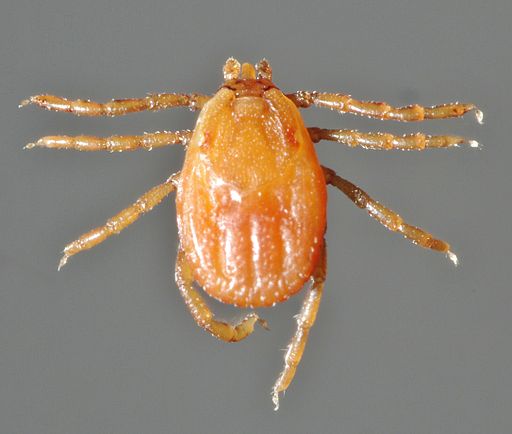SERVICE REQUEST?
Fill out the form below.
Find our nearest location
Your Local Office

Brown Dog Tick
Attribution: Alan R Walker, [CC-BY-SA-3.0], via Wikimedia Commons
Size:
May reach nearly 1/4-inch in length. After taking a blood meal, however, the female may measure about 1/2-inch or larger.
Color:
Uniformly dark reddish brown with no markings.
Behavior:
Brown dog ticks do not confine themselves to dogs but will also attach themselves to many other animals and people. On dogs, adult ticks are typically found on the ears and between the toes, while immature ticks feed along the dog’s back. Outdoors, a brown dog tick crawls up on grasses, shrubs, and other vegetation, then attaches itself to a passing host, which may be a dog, deer, rabbit, person, etc. The brown dog tick is known for infesting homes after being carried inside on pets, usually dogs. Indoors, a female may lay eggs in a crack and after a few weeks, hundreds of young ticks, called larvae, may be seen crawling about in search of a host. Usually, the ticks seek out a dog or cat, but may crawl onto and feed on humans in the home. Larval ticks and adults are capable of surviving long periods up to eight months without feeding. Outdoors, wildlife, such as raccoons and possums, may be responsible for bringing ticks into a yard, or the ticks may crawl into the yard from a neighboring property. The brown dog tick is important because it is known to transmit diseases to humans, including Rocky Mountain Spotted Fever, tularemia, human babesiosus, and human ehrlichiosis. In addition, the threat of bacterial infection is possible at the site of any tick bite, and, in rare cases, may even result in blood poisoning.
Brown dog ticks are greater pests in southern states but not in the north. They are typically found in heavy vegetation and tall grasses where dogs and other animals have been active. In yards, the ticks are usually found around shrubs and in landscaped areas, but will also be found in dog houses and kennels and beneath decks (if the pet has access beneath it). Inside, the ticks drop off the pet after taking their blood meal and crawl into cracks around baseboards, door frames, and window frames.
Ticks are notoriously difficult to control in and around homes. Repeated treatments are often required to finally eliminate the ticks. In some cases where wildlife may be continuing to reintroduce ticks to a yard, continued tick control services may be necessary. Several factors need to be considered when controlling ticks:
- Regular treatment of dogs (and possibly cats) for ticks (completed under the direction and care of a veterinarian).
- Regular inspection of cats and dogs and prompt removal of ticks (completed by pet owner using techniques supplied by a veterinarian).
- Removing or limiting the amount of thick vegetation on the property.
- Trapping and removing wildlife that is coming onto the property (completed by a qualified wildlife removal specialist).
- Treatment of vegetation where ticks are found outdoors (completed by a licensed pest control company, such as Terminix).
- Treatment of cracks and voids indoors where ticks are found to be active (completed by a licensed pest control company, like Terminix).
Patience may be necessary as repeat efforts are often required to produce satisfactory reduction of tick populations, especially outside.
Family Name:
Rhipicephalus sanguineus
Read What Our Clients
Are Saying
My Terminix tech Scott is the best! He is professional, courteous and absolutely thorough about his job. Thank you for sending such a blessed tech to my house. Hamlet, NC
This letter is to say how pleased we are here at Morreene West Apartments with your services. We are very pleased with the technician, Christopher. He does a great job. Durham, NC
Terminix has consistently offered our apartment complex reliable, competent service. We are completely satisfied with their knowledgeable representative who is always punctual and does a superior job for us every time. Chapel Hill, NC
I would like to take the time to thank you for giving us such great service here at Carver Pond Apartments. Your Pest Technician Christopher Mitchell has provided us with excellent service over the last few months. Christopher is such a great help to us in providing helpful information so that we can better serve our residents here at Carver Pond. Durham, NC
SERVICE REQUEST?
Fill out the form below.